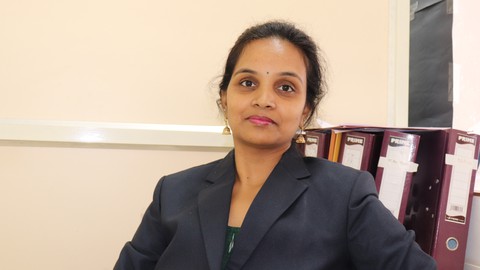
Introduction to PIC18F Microcontroller
Introduction to PIC18F Microcontroller, available at Free, has an average rating of 4.55, with 25 lectures, based on 64 reviews, and has 1541 subscribers.
You will learn about Basic Concepts of PIC18F Microcontroller Basic Introduction to microprocessors and microcontrollers PIC18F Microcontroller Features, Architecture, Memory Organization Introduction to Assembly Language Programming This course is ideal for individuals who are Engineering Students It is particularly useful for Engineering Students.
Enroll now: Introduction to PIC18F Microcontroller
Summary
Title: Introduction to PIC18F Microcontroller
Price: Free
Average Rating: 4.55
Number of Lectures: 25
Number of Published Lectures: 25
Number of Curriculum Items: 25
Number of Published Curriculum Objects: 25
Original Price: Free
Quality Status: approved
Status: Live
What You Will Learn
- Basic Concepts of PIC18F Microcontroller
- Basic Introduction to microprocessors and microcontrollers
- PIC18F Microcontroller Features, Architecture, Memory Organization
- Introduction to Assembly Language Programming
Who Should Attend
- Engineering Students
Target Audiences
- Engineering Students
Microprocessors are used extensively in the design of any computing facility. It contains units to carry out arithmetic and logic calculations, fast storage in terms of registers and associated control logic to get instructions from memory and execute them. A number of devices can be interfaced with them to develop a complete system application. On the other hand, microcontrollers are single chip computers, integrating processor, memory and other peripheral modules into a single System-on-Chip (SoC). Apart from input-output ports, the peripherals often include timers, data converters, communication modules, and so on. The single chip solution makes the footprint of the computational element small in the overall system package, eliminating the necessity of additional chips on board. However, there exists a large range of such products. While the simpler microcontrollers are cheap, their capabilities (in terms of program size and analog and digital peripherals) are also limited. Such processors may be suitable for small applications. Microcontrollers like 8051, PIC belong to this category.
In this course Introduction to PIC18F Microcontroller, history of PIC18, features, architecture, Memory Organization, Registers are discussed briefly and Basic concepts of assembly language programming i.e., Assembler directives, Data formats, Addressing modes, Instruction set with simple examples are discussed
Course Curriculum
Chapter 1: Introduction
Lecture 1: Basic Introduction about Microprocessors and Microcontrollers
Lecture 2: Course Contents
Lecture 3: History of PIC Microcontrollers
Lecture 4: Selection Criteria of Microcontroller
Chapter 2: PIC18F458 Microcontroller
Lecture 1: Features of PIC18F Microcontroller
Lecture 2: Architecture
Lecture 3: Registers
Lecture 4: Status Register
Lecture 5: Peripherals and special features
Lecture 6: Memory Organization
Lecture 7: Timers
Lecture 8: Interrupts, Reset, Minimum Connections for PIC18F458
Lecture 9: Pin description and I/O SFR's
Chapter 3: Assembly Language Programming
Lecture 1: Overview of PIC18F instructions and Assembly Language
Lecture 2: Data Formats
Lecture 3: Assembler Directives
Lecture 4: Addressing Modes
Chapter 4: Instruction Set
Lecture 1: Move and Load Instructions
Lecture 2: Arithmetic Instructions
Lecture 3: Logic Instructions
Lecture 4: Bit Manipulation Instructions
Lecture 5: Call and Return Instructions
Lecture 6: Branch Instructions
Lecture 7: Test and Skip Instructions
Lecture 8: References
Instructors
-
Dr. Prathiba Reddy
Asst. Prof. at G H Raisoni College of Engg. & Management
Rating Distribution
- 1 stars: 1 votes
- 2 stars: 2 votes
- 3 stars: 10 votes
- 4 stars: 14 votes
- 5 stars: 37 votes
Frequently Asked Questions
How long do I have access to the course materials?
You can view and review the lecture materials indefinitely, like an on-demand channel.
Can I take my courses with me wherever I go?
Definitely! If you have an internet connection, courses on Udemy are available on any device at any time. If you don’t have an internet connection, some instructors also let their students download course lectures. That’s up to the instructor though, so make sure you get on their good side!
You may also like
- Best Yoga Instruction Courses to Learn in March 2025
- Best Stress Management Courses to Learn in March 2025
- Best Mindfulness Meditation Courses to Learn in March 2025
- Best Life Coaching Courses to Learn in March 2025
- Best Career Development Courses to Learn in March 2025
- Best Relationship Building Courses to Learn in March 2025
- Best Parenting Skills Courses to Learn in March 2025
- Best Home Improvement Courses to Learn in March 2025
- Best Gardening Courses to Learn in March 2025
- Best Sewing And Knitting Courses to Learn in March 2025
- Best Interior Design Courses to Learn in March 2025
- Best Writing Courses Courses to Learn in March 2025
- Best Storytelling Courses to Learn in March 2025
- Best Creativity Workshops Courses to Learn in March 2025
- Best Resilience Training Courses to Learn in March 2025
- Best Emotional Intelligence Courses to Learn in March 2025
- Best Time Management Courses to Learn in March 2025
- Best Remote Work Strategies Courses to Learn in March 2025
- Best Freelancing Courses to Learn in March 2025
- Best E-commerce Strategies Courses to Learn in March 2025






















